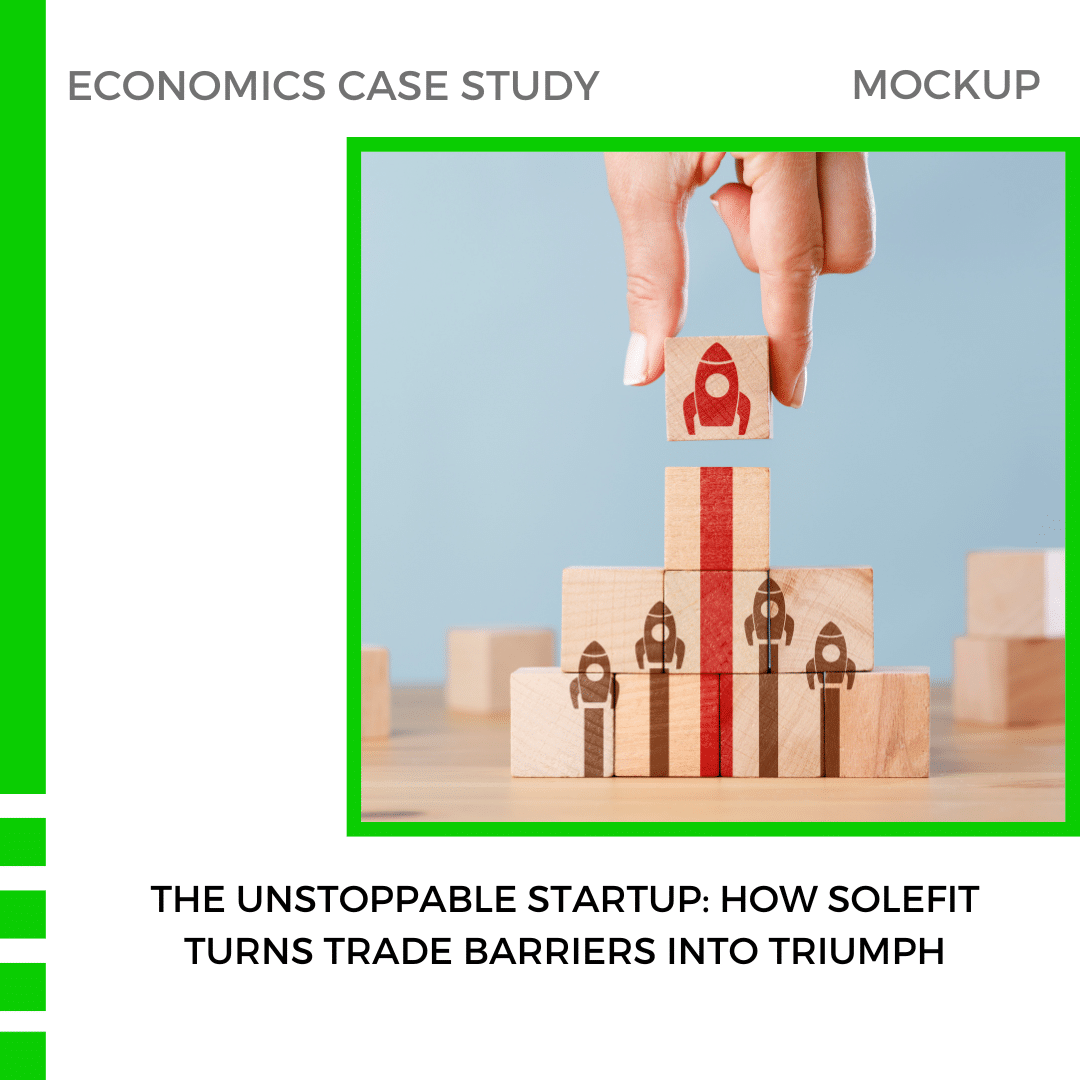
The Unstoppable Startup: How SoleFit Turns Trade Barriers into Triumph
Introduction
This case study explores the challenges faced by SoleFit, a fictional startup operating in the competitive shoe market. Like many startups, SoleFit began with high ambitions, identifying a gap in the local footwear industry by offering stylish and affordable shoes. The company sourced its shoes from Chinese manufacturers known for superior craftsmanship and competitive pricing to maintain product quality and keep costs manageable. However, unexpected import duties have jeopardized the startup’s financial health, raising critical questions about its future.
This case focuses on the financial, operational, and strategic challenges startups face when navigating complex trade policies. SoleFit must now explore new strategies, including the feasibility of local manufacturing, adjusting pricing, or pursuing government advocacy. Students will analyze SoleFit’s situation, propose actionable solutions, and develop a roadmap to ensure the startup’s long-term survival and growth despite the obstacles presented.
To learn more about how startups develop strategies for success, visit Startup India.
Background of SoleFit
Company Overview
Founded in 2022, SoleFit is a young, ambitious startup that offers high-quality, affordable footwear to urban professionals and fashion-conscious consumers. Positioned as a premium brand, it quickly gained traction thanks to positive feedback on its designs and comfort, setting the stage for future growth.
Market Position
SoleFit initially captured a significant market share by focusing on quality and style. The brand’s alignment with the consumer trend towards comfortable yet fashionable footwear positioned it as a desirable choice among customers.
Import Strategy
Given the absence of advanced local manufacturing facilities, SoleFit relied on importing from China to ensure quality. The pricing advantage of these imports allowed SoleFit to compete effectively within the premium footwear segment.
Key Events Leading to the Challenge
High Import Duties
In 2023, SoleFit’s government introduced steep import duties to promote local industries. This decision increased the cost of imported shoes, significantly squeezing SoleFit’s margins and threatening the startup’s sustainability.
Limited Domestic Manufacturing Capability
While SoleFit explored local production as an alternative, domestic manufacturers lacked the technology and craftsmanship required for premium footwear. Upgrading local facilities would demand time and heavy capital investments, adding further uncertainty.
Financial Strain
The rising import costs resulted in financial pressures, forcing SoleFit to either absorb the additional expenses or pass them on to customers. Each option posed risks, threatening its competitiveness or consumer demand.
Immediate Impact on SoleFit
Increased Costs
The import duties caused a sharp rise in SoleFit’s production costs, forcing the startup to reconsider its pricing model and operating strategy.
Pricing Dilemma
To offset increased expenses, SoleFit faced the dilemma of raising prices. However, with competitors offering cheaper alternatives, the brand risked alienating its customer base.
Operational Challenges
The company’s finances were stretched thin, impacting its ability to manage cash flow, maintain inventory, and invest in marketing. Without a solid financial strategy, SoleFit risked losing momentum.
Strategic Challenges
Cost Management
SoleFit must optimize costs by negotiating better terms with suppliers, finding alternative sourcing locations, or identifying cost-saving opportunities within operations.
Feasibility of Local Manufacturing
Establishing local manufacturing is a potential solution but requires careful assessment. The startup must evaluate the cost of new machinery, the time required to train workers, and whether local production can meet its quality standards.
Pricing Strategy
SoleFit must develop a sustainable pricing strategy that balances profitability with customer expectations. Offering limited-time discounts or subscription models may help maintain customer loyalty without sacrificing margins.
Government Engagement
Engaging with the government to secure subsidies or reduced import duties could provide the financial relief SoleFit needs. Collaborating on public-private initiatives could also stimulate local manufacturing improvements.
Tasks for Students
Task 1: Cost Analysis
Evaluate the financial impact of import duties on SoleFit’s operations. Determine whether importing remains viable or if local production offers a sustainable path forward.
Task 2: Feasibility Study on Local Manufacturing
Analyze the costs, risks, and benefits of shifting to domestic manufacturing. Explore potential partners and assess required investments in technology and labour.
Task 3: Alternative Sourcing Options
Identify other countries or regions offering favourable trade terms with SoleFit’s home country to reduce dependency on Chinese imports.
Task 4: Pricing Strategy Development
Create a pricing model that reflects the value of SoleFit’s offerings without alienating customers. Consider dynamic pricing or bundling options.
Task 5: Engagement with Government
Design a strategy to negotiate with government stakeholders. Suggest possible incentives or phased import duties to support startups.
Task 6: Marketing and Branding Plan
Develop a communication plan that promotes SoleFit’s value proposition while addressing any changes to its sourcing strategy. Highlight efforts to support local industries to win customer trust.
Possible Solution
A potential solution for SoleFit is to adopt a hybrid sourcing strategy, combining imports with gradual local production. Initially, the startup can reduce reliance on high-cost imports by identifying alternative suppliers in countries with favourable trade agreements, such as Vietnam or Indonesia. Simultaneously, SoleFit can collaborate with local manufacturers, offering training and technology partnerships to enhance production capabilities over time.
SoleFit can introduce subscription models or pre-order campaigns to manage cash flow and maintain brand loyalty. These campaigns encourage customers to pay in advance for new collections, ensuring a steady revenue stream while reducing the need for excessive inventory.
By proactively engaging government stakeholders, SoleFit can seek support through public-private partnerships to modernise domestic manufacturing. Exploring subsidies for importing raw materials rather than finished products might also provide financial relief.
For startups looking to overcome similar challenges, explore more on Startup India or learn about trade incentives at Make in India.
Conclusion
The case of SoleFit encapsulates the complex challenges startups face when confronted with shifting trade policies and local manufacturing limitations. This startup must decide between absorbing rising costs, adjusting pricing strategies, or investing in local production with uncertain outcomes. Students can propose creative solutions to navigate these challenges by analysing the situation from multiple perspectives while ensuring sustainable growth.
This case study highlights the importance of strategic flexibility, innovative sourcing strategies, and effective government engagement for startups operating in volatile markets. It also emphasizes the need for startups to build resilience into their business models to withstand unforeseen disruptions and remain competitive.
Explore Business Models of Global Companies and Indian Companies
Tag:case studies, case study, economics case study, hybrid sourcing, import duties impact, import vs local production, local manufacturing startup, managing startup costs, mockup case study, premium footwear startup, SoleFit case study, startup, startup challenges, startup government engagement, startup survival strategy



